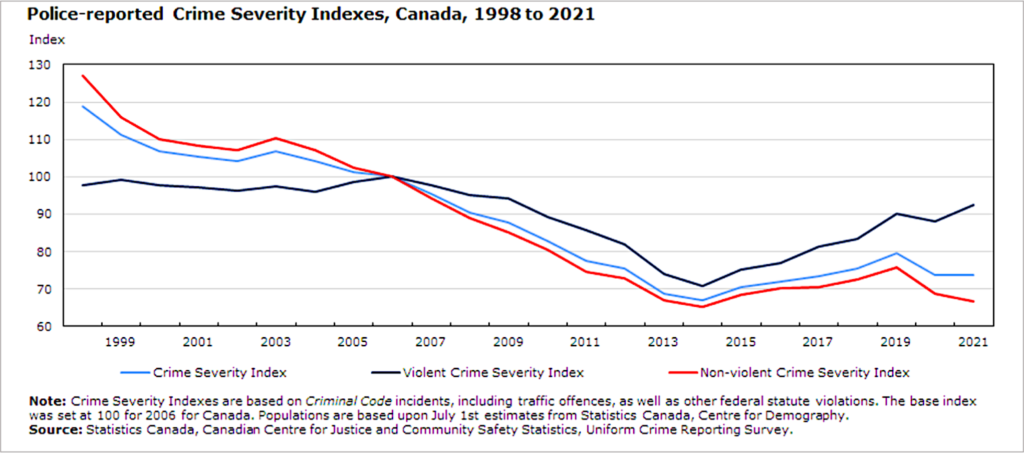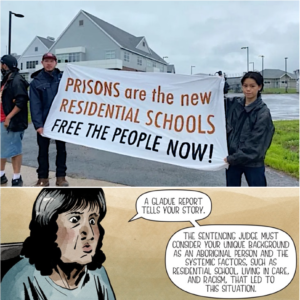The “ideal” size of a country’s prison population can be hotly debated from several angles, but it surely should not be based on racial targets dreamt up by activists; instead, it should reflect the number of criminals (of whatever race) who require incarceration. Canada’s incarceration rate, incidentally, has been on a steady decline due to the Trudeau government’s criminal justice policies. The rate (including provincial and federal prisons) has fallen from 138.9 per 100,000 adults in 2015/16 to 101.7 per 100,000 in 2022/23, a decline of 27 percent in only seven years. At the same time, however, crime has risen. During the same period, Canada has suffered a 10-point increase in the crime severity index and a 24-point increase in the violent crime severity index.

Pretendian Social Policy
Beyond demanding what amounts to a general amnesty for black convicts, the Black Justice Strategy seeks to pervert Canada’s justice system along racial lines in other damaging ways. Recommendations #64 to #66 would encourage judges to deliver lighter sentences to black Canadians through the use of Impact of Race and Culture Assessments. These would be modelled after the “Gladue reports” that have infected the justice system’s treatment of Indigenous offenders and which have the effect of arguing for more lenient sentences based solely on race. The underlying, deeply offensive, assumption is that because a person is Indigenous, they are not fully responsible for their own actions. Now, activists are telling the Trudeau government the same favouritism should be extended to blacks.
The evidence to date shows Gladue reports have not benefitted the Indigenous community. The share of native Canadians in prison has actually doubled since the Criminal Code of Canada was amended in 1996 to allow Gladue reports. And the policy of leniency for native offenders has made life substantially more dangerous for law-abiding Indigenous Canadians. According to Statistics Canada data, from 2014 (the first year race-based data became available) to 2023, the annual number of Indigenous homicide victims grew by 60 percent, outpacing the growth rate for the rest of the population of 40 percent. As for those accused of homicide, the Indigenous share was up by 33 percent compared to just 12 percent for the rest of the population.

The ultimate effect of measures meant to divert Indigenous offenders from jail can be seen in the horrifying 2022 James Smith Cree Nation murder spree, when Myles Sanderson killed 10 people on or near the reserve, and wounded another 18. Prior to his murderous rampage, Sanderson had been charged with 125 crimes, many of which were extremely violent. Yet many of his prospective prison sentences were significantly truncated by repeated use of Gladue reports; at the time of the killings Sanderson was supposed to be serving a four-year federal sentence for numerous violent acts, including stabbing someone with a fork. Instead he received a “statutory release” from prison, and then promptly disappeared.
The lesson from the James Smith Cree Nation murders is that the Indigenous community is poorly served by the premature release of Indigenous criminals. These individuals tend to return to their home communities, where they repeatedly re-offend. The situation will be no different for Canada’s black communities. Pushing hardened criminals back into the public to reoffend at their leisure represents a failure of one of the most basic functions of a justice system – to keep the public safe.
Curiously, the Black Justice Strategy’s authors seem fixated on conflating the experience of Indigenous Canadians with those of immigrant black Canadians. “As long as Black people have been in Canada, Indigenous and Black struggles have been intertwined,” the report states. This claim is utterly preposterous. The histories of these two groups could not be more different. For Owusu-Bempah and Jones to cast Canada’s black immigrant community – some of whom were actual agricultural settlers little different from white pioneers – in the same light as native peoples who had been in what became Canada for thousands if not tens of thousands of years seems an embarrassing example of what has come to be known as “Pretendian” social policy.

In a final insult to anyone who thinks justice should be colour-blind, Recommendation #67 calls for the creation of special provincial courts that would only hear cases for black offenders. In this way, the authors want to establish an entirely race-segregated legal system. Dispensing justice based solely on racial identity is entirely unjust and can only stoke racial resentment throughout the country. Black Canadians would inevitably regard their separate courts as an insult, while non-black Canadians would wonder why their neighbours were getting special treatment.
Bail Out
Such special courts may never be necessary, however, as the Black Justice Strategy seeks to ensure that most criminals never see the inside of a prison at all, either pre- or post- trial. Recommendation #45 would require judges to consider the circumstances and background of every accused person applying for bail, effectively encouraging judges to grant bail even more often than they already do, and for reasons beyond the facts of the case. Once a judge granted an accused person bail, recommendation #46 would allow the accused to stay out on bail even if they committed another offence.
This is a particularly odd policy suggestion, since the Justin Trudeau government already made bail much easier to obtain through its 2018 amendments to the Criminal Code. Since then, the country has been aflame with complaints about these changes – widely characterized as a “catch and release” policy due to how it has rendered police impotent at clearing the streets of even the most habitual offenders, and the resulting overall increase in criminal activity. Canada’s premiers recently demanded that the Trudeau government seriously tighten the bail system. And in Ontario, Conservative Premier Doug Ford has vowed to release bail data classified by individual judge and court, to bring public focus and transparency to the issue.

